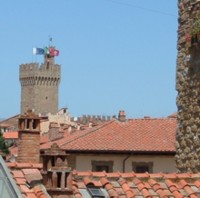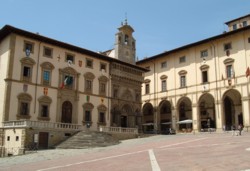Arezzo Tourist Information
Arezzo is a provincial capital within the central Italian region of Tuscany (Toscana). Like so many Italian towns, the historic part of the city is on a hill, in a defensive position close to the base of a stronghold. The lower part of town, around the railway station, is more modern, with a well-ordered and prosperous buzz. More medieval than grand, the town isn’t as breathtaking as Tuscany’s finest, but it’s an attractive place to visit, with plenty to keep the visitor occupied.
Arezzo’s most powerful period came in the Middle Ages, before the town was taken over by Florence. Consequently the historic part of town is predominantly medieval, giving Arezzo a humbler and quainter air than Renaissance Florence. The best way to see the town is to pick up a map from Arezzo’s tourist information office (Piazza della Repubblica, by the station) and wander. A stroll around the winding streets takes in the town’s sights and several interesting churches and palazzi. Highlights include the sloping Piazza Grande and the cathedral, the Duomo, which contains fine stained-glass windows and an elaborately carved tomb recounting the life of Bishop Guido Tarlati. Beind the cathedral is a pleasant leafy park, leading up to the sixteenth-century Medici fortress, which offers impressive views over Arezzo and the surrounding countryside.
Arezzo’s greatest artistic treasure is the set of frescoes by Piero della Francesca called La Leggenda della Vera Croce, in the church of San Francesco. Started in 1452, this Renaissance masterpiece tells the story of the ‘True Cross’. Entrance is by timed admission ticket, which can be booked in the office next door. An audioguide is included.
Arezzo has several interesting museums, in addition to the Piero della Francesca frescoes. The Museo Statale d’Arte Medievale e Moderna is housed in the fifteenth-century Palazzo Bruni-Ciocchi, and contains works of art from the Middle Ages onwards, including sculptures, paintings and a large collection of Majolica ware. Children who are bored of the art may be more interested in the museum’s hoard of historic weapons. Nearby, the Museo di Casa Vasari is another interesting stop for those interested in art. The painter Vasari decorated his own house with rather overpowering mannerist frescoes; modern visitors can wander the rooms and wonder how he could have lived surrounded by quite so much of his own work. Down in the lower town, alongside the ruined Roman amphitheatre, is the town’s Museo Archeologico. Arretium, as it was called then, was a busy Etruscan and Roman town, and its relics are lined up here; roomfuls of vases, mosaics and funerary urns. The three museums and the frescoes in San Francesco are included on a good-value 2-day ticket.
Arezzo is renowned for its antique fairs, which take place on the first Sunday of every month, and the preceding Saturday. A medieval reenactment, the Giostra del Saracino takes place twice a year, on the third Sunday of June and the first Sunday of September.

Arezzo Travel Information
Arezzo is on a slow railway line between Florence and Rome, and is well-served by trains from both cities. The railway station is in the lower part of town, a short walk or bus ride from the historic centre.
La Vita è Bella / Life is Beautiful
The Oscar-winning film by Roberto Benigni about wartime Italy was set and filmed in filmed in Arezzo. Proud of the film connection, the streets of Arezzo are dotted with information boards about the film locations, helping film fans to identify the spot where the characters sheltered under a cushion umbrella, or cycled through the piazza.
> Buy Life Is Beautiful from Amazon.co.uk
Accommodation
There are good hotels both in Arezzo and in the surrounding countryside, as well as good-value and characterful B&Bs and holiday rentals.
> Arezzo hotels, B&Bs and holiday homes
Useful links
